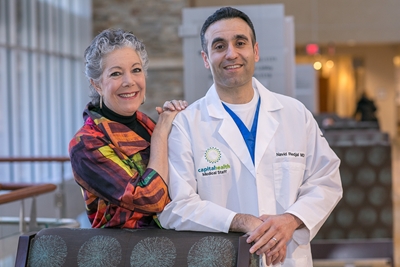One morning in November 2017, Kate Watson was straightening up her house in nearby Hopewell Township, NJ. By late afternoon, she was considering awake brain surgery to remove a large tumor compressing critical brain areas.
If you were to draw a picture of what an MRI revealed inside 61-year-old Kate Watson’s brain back in November 2017, you would make a chubby, peanut-shaped object, about the size of a lemon, a little to the left of the center of her head.
Kate’s tumor was large, and it resided in the left frontal temporal area of the brain known as Broca’s, which is responsible for speech production, and Wernicke’s area, which controls comprehension. She was already showing signs of its impact when she came into the hospital for a concussion. She was confusing her words. “I had hit my head, and I told my friend that I didn’t feel a dent, but I was seeing straws instead of stars” Kate says.
Dr. Navid Redjal, director of Neurosurgical Oncology at the Capital Health Center for Neuro-Oncology, part of its Capital Institute for Neurosciences, explained that the tumor appeared to originate in the covering of the brain known as the dura. The tumor had compressed, and possibly infiltrated, critical speech areas of the brain. Although the tumor did not appear to originate from the center of the brain, it didn’t mean it wasn’t dangerous or even potentially deadly. “In the brain, the tolerances are small, the space is small, and anything that gets bigger can cause significant difficulties,” he says. “What matters is how the tumor is behaving.”
While the idea of an awake surgery can be unnerving to some people, Kate didn’t hesitate to choose it when the doctors presented her with options. “They said, ‘We can do traditional surgery, or we can do an awake craniotomy.’ I said, ‘Awake surgery. That’s what we’re doing,’ It was my immediate response. I knew I wanted to be awake and to give feedback during the surgery. I also had total faith in my team of doctors because I had seen their work before when a family friend needed surgery. Dr. Redjal and his team are so human. You can feel the compassion,” she says. “They had already gone way beyond the call. They were advocating for me well beyond the operating room.”
Dr. Redjal underscores his belief that the procedure was the best way to tackle the tumor without impacting brain function, specifically Kate’s speech. “With the awake

craniotomy, we are able to constantly monitor her speech while at the same time removing as much of the tumor as possible,” he explains.
While there are some aspects of the surgery Kate doesn’t remember, she recalls each medical person in the operating room introducing themselves to her by name, explaining the role they would play during the surgery and how they would interact with each other. In the case of an awake craniotomy, the team includes the neurosurgeon, the neuro monitoring team, the neuro-anesthesiologist, the surgical physician assistant, and the OR nurse, all of whom play crucial roles during the surgery while they work to ensure that the patient’s brain function remains intact throughout. Neurosurgeons at Capital Health have tools, such as advanced brain mapping and intra-operative neuro-navigation, that allow them to stimulate areas of the brain while the patient is awake and create a map of areas that should be avoided during surgical resection.
After they properly numbed the area they would be operating on and provided the necessary level of anesthesia to keep her sedated but not unconscious, doctors put Kate under a tent with a nurse who would speak to her throughout the surgery and ask her questions when feedback was necessary to guide the surgeon. “She asked me things, like ‘What can you do with a shirt?’ Apparently, I gave a whole paragraph on dry cleaning and properly hanging up clothes,” says Kate.
From a medical standpoint, the purpose of keeping Kate awake and asking her questions that required that kind of response was to monitor her brain as they operated. “We can monitor cranial nerves, for example, when the patient is asleep, but speech is a very complex function that requires multiple different systems, and to really assess it, the patient has to be awake,” Dr. Redjal explains. “It provides us with real-time feedback and helps us gauge how aggressive we’re going to be in terms of resection. It helps us avoid permanently damaging the brain while we’re trying to cut away the tumor.”
Kate went home with her sister about 36 hours after her awake craniotomy. While she struggled for the first five months to follow some of the instructions to help her brain heal—avoiding reading for long stretches of time or really exercising the brain too rigorously—her overall prognosis is good. Less than six months from surgery, Kate is back to work and is avidly writing and reading again, building a nonprofit to assist US Servicewomen in their transition from the military to civilian life. She feels grateful for the concussion that initially brought her into Capital Health in November and resulted in life-altering surgery. Kate says, “It’s not enough to simply put ice on that concussion! I’m so grateful that a bump on the head led me to my Capital Health neuro-family. I can’t say enough for this wonderful community hospital; care, compassion and advocacy extraordinaire!”
To learn more about Capital Health’s Center for Neuro-Oncology, visit capitalneuro.org.